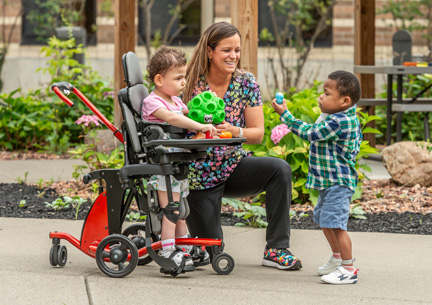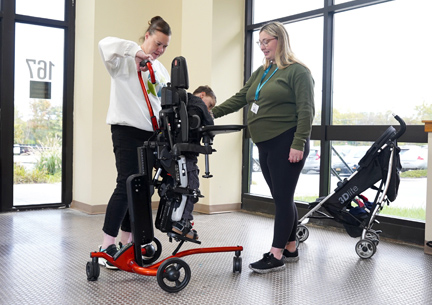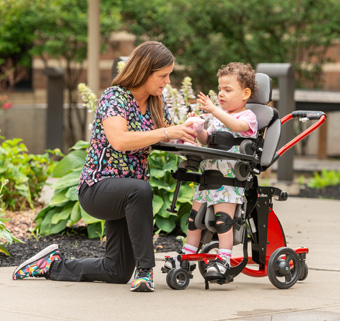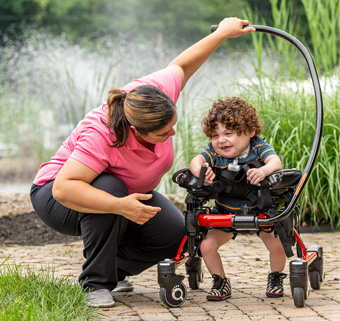A Learning Environment for Your Child with Cerebral Palsy: Part 3
Standing
| October 2010 Cerebral palsy is a condition that affects posture and movement. Insufficient postural control makes it difficult for the children to maintain a position and to keep their balance.
Cerebral palsy is a condition that affects posture and movement. Insufficient postural control makes it difficult for the children to maintain a position and to keep their balance.
When Chris sits he may fall backwards or to the side. He stands with support but without help he cannot do it. Anna can sit and play in tailor sitting on the floor or in her chair at the table. When she stands at her play table or at the couch she needs help as she may lose her balance any time. Matt just learned to pull to stand in his walker. He is taking steps, but he cannot stand on his own and is afraid to practice.
What can parents do for children like Chris, Anna and Matt to make standing easier and safer at home? Safety is important. If your child feels safe she will like to pull up and stand and do so frequently. The more she practices standing, the more improvement you will see. After all, practice makes perfect.
Let’s explore what helps us keep our balance. What do we do when balance is threatened? You step onto the moving walkway at the airport and feel like falling backwards. What do you do? You quickly hold onto the side rail. What do you do when you lift one foot to dry it after your morning shower? You lean against the wall, right?
There are two ways to keep you from falling when you are unsteady. The two strategies are:
- Holding onto something stable
- Leaning against something stable
Holding on provides the best security.
Busses, streetcars, trains and boats have grip bars, poles or railings for passengers to hold onto to prevent falls. Leaning against a wall or bracing yourself with one or both hands against a wall helps your balance, but does not provide the same degree of safety.
Holding on is the safest strategy. Therefore, it benefits children with cerebral palsy most. Even if your child practices independent standing while lightly touching a wall during therapy sessions, you want to reinforce the holding-on strategy at home. At home your child needs more security because he is distracted, likes to do his own thing, is not at his best behavior, and so on. Also, at home you may have hardwood floor and no cushy mats. All told, a fall at home is much more likely to occur and be more hurtful than in the therapy setting. For these reasons let’s explore how you can help your child to use a safe holding-on strategy at home.
Your first task will be to find something really good for your child to hold onto. A stable vertical or horizontal bar is easiest to grasp and hold on to. You want a bar of the right size for your child’s hand. Something she can grasp around, so her finger and thumb will touch or almost touch. In addition, the bar needs to be in easy reach – chest-high or waist-high.
You wander around your place and look. Do you have an open staircase with spindles or a railing with spindles? Both may work well to practice standing. Do you have a chair with spindles? It may work if it is sturdy enough. You don’t want to use a chair that would suddenly move or tip over with your child. Do you have a baby crib? The slats of the crib may be just right for your child to hold onto. How about a towel bar? Do you have a low one in the kitchen or in your bathroom?
Rifton makes a grab bar with two super strong suction cups which you can mount to any smooth surface. It is not designed as the primary support for sit-to-stand or floor-to-stand transfer. But when attached to a horizontal surface for a child who only needs a small amount of balance support when standing, it can be very appropriate.
Another option is to use something with a nice rounded rim for your child to hold onto. A plastic waste paper basket or trash can - filled with an old phone book, magazines, a sack of potatoes or whatever heavy object you can find - will make a sturdy standing station that you may assemble wherever you like.
Bryce’s family had a big bucket planter on the front porch. It was filled with good dirt, but no flowers got planted. It was Bryce’s bucket. He loved to stand at it. His Dad told me: “When Bryce is upset about something, we go out and I sit down with him by the planter. Before you know it, he pulls up, stands and is happy”. Playing at the bucket was an adventure for Bryce. Looking for stuff in the bucket – a dried leaf, a little stick or stone in the dirt, was exciting. It motivated him to learn several new skills: holding on, pulling up, standing with two hand support, standing with one hand support, leaning forward, and coming back down.
Matt’s Standing Stations
 If your child is already walking with a walker like Matt, it is not enough to have one bar somewhere. Matt moves around with his walker or by crawling. Pulling to stand is not hard for him. The more safe standing places he has, the more he will practice and the more motor learning will occur. Matt’s parents installed a sturdy bar next to the toilet just for him. His youth bed has a side rail he can hold on to. His Mom has him stand there when she helps him get dressed in the morning. When Matt is ready for a big bed, they will look for one that has a head and foot board with spindles or a cross bar. Close to the refrigerator is a bar suctioned to the kitchen counter. Matt holds on to it when he opens the refrigerator to get a snack. The family room has a sturdy play table with a rim. Matt loves to play at the table. Being able to hold onto the rim gives him the extra security he still needs.
If your child is already walking with a walker like Matt, it is not enough to have one bar somewhere. Matt moves around with his walker or by crawling. Pulling to stand is not hard for him. The more safe standing places he has, the more he will practice and the more motor learning will occur. Matt’s parents installed a sturdy bar next to the toilet just for him. His youth bed has a side rail he can hold on to. His Mom has him stand there when she helps him get dressed in the morning. When Matt is ready for a big bed, they will look for one that has a head and foot board with spindles or a cross bar. Close to the refrigerator is a bar suctioned to the kitchen counter. Matt holds on to it when he opens the refrigerator to get a snack. The family room has a sturdy play table with a rim. Matt loves to play at the table. Being able to hold onto the rim gives him the extra security he still needs.
“Don’t Matt’s parents overdo it?” you may ask. “Won’t he become dependent on holding- on all the time?” I don’t believe so. The many safe standing opportunities make it possible for Matt to do many tasks in standing, just like his able-bodied peers do. That’s good for his development, it’s good for his bones, it’s good for his self esteem, and improves his balance. As his postural control improves he will spontaneously hold on less.
Anna and Chris learn to stand holding on
Anna and Chris both can reach and hold toys, yet they have not started to reach out and hold onto something sturdy when they stand. Anna stabilizes herself by leaning against a sturdy object and Chris relies on his parents to support him. Both would benefit from holding on in standing. If your child stands like Anna or Chris, talk to your therapist about standing with arm support. Holding on is more difficult than holding a toy. It may take some time before your child acquires the hand, arm, and shoulder strength and coordination to hold on safely. Usually children with high muscle tone (hypertonia) learn to hold on quicker than children with low muscle tone (hypotonia). For children with very low muscle tone, holding-on may not be a successful strategy. In addition, a child’s motor planning skills will affect progress.
Anna’s parents talked to her physical therapist about her unsteadiness when standing. “Would it help her to hold onto a bar?” “Let’s give it a try” was the answer. The therapist practiced standing holding on during therapy sessions and helped the parents to do the same at home. Anna was able to hold onto the bar suctioned to her table just fine. But she rarely did so. She liked to lean against her table and play with both hands. Holding on with one hand, planning ahead for a loss of balance, was no match for her happy-go-lucky personality. Her therapist decided that teaching Anna to fall safely and training lowering herself from standing with control was more helpful at the moment. Later, after her balance and the coordination had improved, Anna tried to walk. As she took steps along the couch, she used her arms to support herself and she also held onto something sturdy. Now it made sense to her.
Chris’s parents got a plastic trashcan with a nice rim. It came up to his chest – just the right size for Chris. To make it sturdy Dad had the idea to fill it 3 quarters with golf balls. Chris needed help to grasp the rim and pull up. As he stood Mom was at his side and had her hands placed over his to make sure they would not slip off. Chris was scared to stand all by himself. Mom counted to 10, and then it was time to sit down and rest. It took many trials and patient practice before Chris could hold on well and lost his fear of falling. And then it appeared - that big smile- that showed how happy and proud he was to stand all by himself. That made it all worthwhile. Soon he loved to stand and learned to hold on with just one hand without falling. Like Bryce, Chris taught himself to lean forward, reach in with one hand and play.
Benefits of standing
Standing is good for all children including children with cerebral palsy. It stimulates leg muscle activity; it stretches and activates the muscles of the hips, legs, ankles and feet, and puts healthy pressure through the bones and joints. Weight bearing in standing causes calcium to be deposited in the child’s leg bones, and, as a result, the bones become denser and stronger.
When your child is not ready to practice standing, your therapist may recommend a stander for him or her. Many years ago, when I started as a therapist, it was difficult to find a stander for the children. Fortunately, this has changed. Good people, good teams, good companies like Rifton have created a great variety of standers that provide optimal support. They give children with cerebral palsy the possibility to play or work in standing without fear of falling.
For Further Reading:
Part I: A Learning Environment for Your Child with Cerebral Palsy: 0 to 18 Months
Part II: A Learning Environment for Your Child with Cerebral Palsy: 18 Months to 5 Years
Sieglinde Martin, M.S., P.T., is a physical therapist with more than thirty years of experience working with the families of children with cerebral palsy. Ms. Martin obtained her degree in physical therapy from the University of Cologne, Germany, and her Master of Science degree at Ohio State University in Columbus, Ohio.
Currently she works at Nationwide Children's Close To Home Health Care Center in Westerville, Ohio. She is the author of Teaching Motor Skills to Children with Cerebral Palsy and Similar Movement Disorders: A Guide for Parents and Professionals (Woodbine House 2006) and of Pediatric Balance Program (Therapy Skill Builders, 1998).




